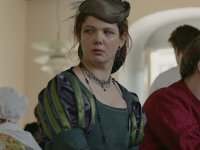Disclaimer: The opinions expressed herein are those of the authors and do not necessarily reflect the official policy or position of Nordiclarp.org or any larp community at large.
Why Larp with History?
Human history as a setting for larp goes back to the earliest days of the form – even to before larp was identified as a special kind of activity in its own right, in the committee games and fictionalized simulations that preceded the larp that we know today.
What makes history so appealing?
- The richness, range, and depth of the real historical tapestry is such as to make it inexhaustibly appealing as a source of larp material. From Ancient Egypt (Queen of Denial, Barnard and Holkar, 2014) to medieval Britain (The Lists of Avalon, Barnard, Jones and Jones, 2011) to the Industrial Revolution (Railways and Respectability, Barnard and Dall et al., 2007) to the Korean War (M*A*S*H: Brothers in Arms, Barnard and Dall et al., 2013), there’s something for everyone. And provided you avoid exoticization and respect the people involved, the whole spectrum is available to you.
- Familiarity to participants is another advantage: they may already be familiar with the chosen historical milieu, or, if not, they can easily make themselves familiar by using readily-available reference materials. Compare the difficulty of communicating familiarity with a fictional setting whose details are only available in the minds of the designers.
- Historical settings lend themselves readily to parallels and lessons related to life today, for the more instructive school of larp design. For example, the 1970s Berlin of “Heroes” (Holkar, 2016) studies attitudes towards the demonized Other, and how similarities, once exposed, may resonate more strongly than differences. The distance of the setting helps to make clear the significance of the themes in our own world.
- And there’s no denying the emotional power and resonance of larping historical events — perhaps those in which one’s own ancestors, or national predecessors, might have been involved.
- But a larp design that draws upon history has, perhaps, first to consider the limitations and biases of our societal defaults of historical understanding and analysis.
The Problem with History
We must recognise that our knowledge of history is filtered by the (necessarily limited) information that we have about it. We may have access to written accounts from the period: but who wrote them, and why? We may have artefacts, structures, and other physical remains: but who has interpreted them to us? What assumptions did those interpreters make?

Fairweather Manor is an example of a larp based upon historical fiction that explores the dynamics between characters of different classes and genders. Photo courtesy of Dziobak Larp Studios.
To generalise: surviving historical texts were largely written by educated and wealthy men. And these texts, and non-textual historical remains, have also until recently largely been discussed by educated and wealthy men. Even if the author of your direct source is not in that category, you have to ask: who then were that author’s sources and to what extent did they question them? So, for example, Georgette Heyer wrote a feminized take on the British Regency period[1]Georgette Heyer, Regency Buck (London: William Heinemann, 1935). in which women have a greater focus than in historical accounts of the period. But she restricted her scope to the same narrow upper section of society that had been depicted by Jane Austen; she also restricted her research largely to the use of materials left by educated and wealthy men and to the study of decor and costume, rather than establishing what might have been going on in the world outside those stately imagined drawing-rooms. Whether, as an educated and wealthy woman herself, Heyer had any interest in the lives of the poor and underprivileged of that period, we do not know, but she certainly didn’t write about them. If you draw your larp-design inspiration from historical fiction rather than directly from history, you run the risk of inadvertently being on the wrong end of a filter of this type.
Other Histories
The study of women’s history, and people’s history (ordinary people, as distinct from those in power), gives new and fascinating perspectives on familiar historical settings.
“Other” history is of its nature a kind of revisionism: it asserts that traditional historical accounts are partial and/or incomplete. Women’s history draws attention to the roles of women throughout history; it studies the lives and works of individual women, and groups of women, “of note” and otherwise; it examines the effects of historical events on women; and so on. It necessarily questions the privileged values assigned by traditional history to the lives and activities of men. It may also identify situations where women’s actual contributions have been neglected or belittled, at the time or subsequently.
In the same way, a people’s history, also known as a “history from below”, approach to historiography looks at historical events and developments from the point of view of ordinary people rather than leaders. It proactively focuses on the lives of the poor, the dispossessed, and those who in general have no access to power. And it seeks to demonstrate how historical changes that we traditionally ascribe to “great men” are often more the product of inexorable social forces rising from below.

Female characters in Winson Green Prison, a larp about women fighting for the right to vote. Photo by Vicki Pipe for the run at The Smoke Festival 2017.
In A People’s History of the United States,[2]Howard Zinn, A People’s History of the United States (New York: Harper & Row, 1980). Howard Zinn (1980) says:
The history of any country, presented as the history of a family, conceals fierce conflicts of interest (sometimes exploding, most often repressed) between conquerors and conquered, masters and slaves, capitalists and workers, dominators and dominated in race and sex. And in such a world of conflict, a world of victims and executioners, it is the job of thinking people, as Albert Camus suggested, not to be on the side of the executioners.
In larp, even more than in history, positive portrayals of characters are important — because they must be playable. Endowing your female and poor characters with affordances that may not have been demonstrated in the traditional historical record is going to make them more interesting to play, as well as serving the political end of representation. For sure, larp the executioners. They’ll be interesting to play — but the victims don’t have to be just oppression-fodder.
A straightforward example of this kind of “other” history in larp is Winson Green Prison (Sandquist and Göthberg, 2016). It portrays “the women who fought for the equal right to vote, and the men who loved them” — people who at the time were weak, oppressed and despised by society, but who have been vindicated by history. Their struggles are moving and affecting, but we know that they were in the right and that their descendants will see them as heroes. This makes for a good playable mix of struggle and satisfaction.
Historical Responsibility in Larp

Brudpris (2014-, Norway) is a larp that explores the dynamics of a patriarchal society. (Post-game, Photo by Anna-Karin Linder Krauklis)
When looking at and working with historical events and settings via the medium of larp, designers may feel that they owe a responsibility to the people of those times to represent them fairly: to not skew or downplay the depictions of those who have been neglected or diminished by traditional historical accounts. This is not always easy, but it’s a worthwhile use of time. As well as helping to make your design more responsible and understanding, it will also help to make it more interesting and original. There have been countless historical larps in which powerful people make key decisions while lesser folk fill in the background around them; how much fresher and more entertaining would it be to find stories in which women, or ordinary common people can take focus? For example, Dulce et decorum est… (Rider Hill, 2012) depicts a noble family and their influential friends, engaging in political discussion around a dinner table in an English country house in the runup to World War II: a solid and well-proven style of larp setting. Meanwhile Love Letter (Curd, Gammans, McCormick and Perry, 2015) examines the lives of a group of ordinary English village dwellers as the same war impacts upon them — the effects on those who fight, and those who are left behind — caused by the decisions of remote politicians to whom the larp makes no direct reference. Both are successful designs in their own terms, but one is doing something much more unusual than the other.
St Croix (Stamnestrø and Voje, 2015) opens the question of how a power disparity between characters — in this case, slaves and slave-owners — can generate good play for both parties. Slaves have authority over very little, not even their own bodies: how do you empower those players in the larp? What affordances do they have available? Brudpris (Linder and Dahlberg, 2015) partly answered this question by giving its oppressed female characters an unhistorical sexual dominance, so those players were able to compensate, during sexual encounters, for lack of agency in other areas of play.
Beyond the Barricades (Wei and Göthberg, 2015) brings vividly to life the Parisian revolution of 1832. The sides are clear, but one’s relationship to the people alongside whom one stands might not be — especially when unity starts to break down. This design allows for a nuanced approach to social class, and to the development of trust.
War Birds [3]Moyra Turkington, Ann Kristine Eriksen, and Kira Magrann, et al, War Birds (Toronto, Canada: Unruly Designs, 2016). is a collection of six freeforms and larps looking at the war experiences of women; as aviators, refugees, internees, partisans, drivers, or factory workers. It ably demonstrates the range and variety of play experience that can be generated from examining a straightforward other-historical premise.
Moyra Turkington talks, at Living Games Conference 2016, about the genesis of War Birds: following “redlinked” stories in Wikipedia to see the unwritten history of women’s wartime contributions.
The Myth of Authenticity
One argument sometimes given for the dominance of wealthy males in historical larps is that this exercise of privilege is authentic for the period being depicted, and that to show otherwise would be a falsity.
Quite apart from the question of whether the “facts” about the period upon which this view is based are correct or not — as discussed earlier, the filter over historical materials is a highly selective one — it can be argued that the whole notion of authenticity is specious. It’s impossible to larp “the 16th century” from the point of view of the 21st century; all you can ever do is larp an approach to the 16th century, which emerges from the context in which you’re designing.
Our contemporary view of the 16th century is very different from that of historians of fifty years ago; and in fifty years time it will be different again. And as an artistic creator rather than a simulator, a larp designer will draw out themes and messages that resonate particularly strongly with their own contemporary audience. Just as performances of the play Hamlet take on new directions and resonances depending on the political and social currents of the time when they’re being performed, so too do runs of the larp Inside Hamlet (Krauklis and Ericsson et al., 2000; Ericsson et al., 2015).
Deliberate inauthenticity — for example, giving women more prominent and higher-status roles — should not be seen as a betrayal of historical truth. Rather, it can allow a designer to recontextualise history more effectively for their audience. For example, Oss imellom (Hatlestrand and Edland, 2015) includes working-class homosexuals in a middle-class-based organisation that historically would have excluded them, so as better to present the variety of homosexual experience in 1950s Norway. To skew your design in this way, against the power balance of the traditional historical message, is to raise up living underprivileged people against those dead people who have been privileged by the conventional narrative.

The Mixing Desk of Larp design tool features a Loyalty to World slider, where designers can adjust according to playability vs. plausibility. Developed for the Larpwriter Summer School.
Media and Message
It may be that, actually, designing larp directly from the historical record is not your approach. Rather, you might be designing to convey the flavour of media works (books, films) set in that period. A larp set in the Old West is perhaps more likely to be responding to a particular subgenre of Western movie than to the actual history of the period. And a larp set at the 17th-century court of Louis XIV is almost certain to be drawing more heavily on the (19th-century) Musketeers novels of Alexandre Dumas than on documents of the period.
This is no bad thing — resonance with your intended players is more likely to be found within media with which they’re familiar — but it’s another filter to be aware of. Reading Dumas, one would think that all warrior men are strong and masculine, while women are weak, passive, or conniving. However, we know from the existence of historical figures such as La Maupin, Philippe of Orleans, and the Chevalier d’Eon that the 17th-century French court was a much more genderqueer world than the 19th-century novelist was happy to admit; we know that the cowboys of the real Old West were often black, and sometimes women. By looking into history as well as your entertainment-media sources, you can broaden your representation without moving too far away from the material with which your players are familiar. And you should be honest with yourself, and with your players, about whether your game is aiming primarily to be history-based or fiction-based.

The Czech Hell on Wheels is a Western genre larp adapted from the fictional television show. Photo by Potkani.
Techniques for Representation
- Look beneath the surface – Seek out “other” histories as well as mainstream ones. By now, women’s and people’s history are well enough established that a wide range of historical periods have been covered by these approaches.
- Look at the sources – Take in actual history, as well as media depictions of the period. You may find that the way the history has been portrayed on the page or on screen is quite different from modern historians’ understanding of it.
- Ask the logical questions – If women aren’t mentioned in the orthodox account, why might that be? Where were they, and what were they doing? What place did poorer people have in the economy?
- Turn the familiar face of history around – For example, war histories often focus on men who are away fighting, or on the portrayal of the victors as uncontested heroes. How about those family members who stayed at home? – what can you find out about them, that could make for interesting larp?[4]Heroes of the Hearth (Stiainín Jackson, in Seven Wonders (London: Pelgrane Press, 2015) is a tabletop RPG that looks at this situation. How about the experiences of those who were defeated?
- Turn over stones – Why are some periods of history frequently visited by larp, and others neglected? Whose stories are still out there, waiting for a larp designer to pick them up and reflect them as something wonderful?
- Challenge your own assumptions – However well you think you know the period, you may without realizing it be stuck in a skewed account given by a partial historian or fiction writer. Find another source, and see if it backs up or counters your belief.
- Don’t be afraid of inauthenticity – If you feel you need to, you should deliberately adjust the historical “truths” to better make the range of stories that you seek. It’s larp, not re-enactment.
- Check in – If you are yourself wealthy and/or educated and/or male, make sure that you’re not inadvertently carrying your own society’s tacit assumptions into the design. Involve people from other groups in your work. Build more balanced perspectives by working together.
The Ends of History
A historical setting for a larp can be a wonderful thing, but it can also be a painful and betraying thing. You can make sure that you’re giving your design ideas, and the play aspirations of your larpers, the maximum opportunity to express themselves by engaging with history critically, by putting in the exploratory work around it, and by looking for stories that haven’t been told.
When it all comes together just right, you can be sure that your larp design and its enaction will earn their own places in the history of the artform. Take a look at Just a Little Lovin’ (Edland and Grasmo, 2011), the story of an assortment of people with little in common apart from their relentless othering by the media and those in power, finding community together, turning suffering into love. Their stories are respectfully told, solidly researched, and thoroughly contextualised. A larp like this brings its history to raging, pounding life — and makes its messages speak to our hearts and to our minds.
Thanks to Liz Lovegrove and Becky Annison for their help and ideas during the writing of this article.
Ludography
- Nickey Barnard, Philippa Dall, and Jerry Elsmore, et al. Railways and Respectability. Retford, UK: UK Freeforms, 2007.
- Nickey Barnard, Philippa Dall, and Tony Mitton, et al. M*A*S*H: Brothers in Arms. Hoburne, UK: Consequences, 2013.
- Nickey Barnard and Mo Holkar. Queen of Denial. Hoburne, UK: Consequences, 2014.
- Nickey Barnard, Helen Jones, and Martin Jones. The Lists of Avalon. Hoburne, UK: Consequences, 2011.
- Natalie Curd, Roger Gammans and Elyssia McCormick, et al. Love Letter. Hoburne, UK: Consequences, 2015.
- Tor Kjetil Edland and Hanne Grasmo. Just a Little Lovin’. Norway: Lunde Leirsted, Norway, 2011.
- Martin Ericsson, Bjarke Pedersen and Johanna Koljonen. Inside Hamlet. Helsingør, Denmark: Odyssé, 2015.
- Jeanita Hatlestrand and Tor Kjetil Edland. Oss imellom. Oslo, Norway, 2015.
- Mo Holkar. “Heroes”. Hobro, Denmark: Fastaval, 2016.
- Daniel Krauklis, Martin Ericsson and Holger Jacobsson, et al. Hamlet Inifrån. Sweden: Interaktiva Uppsättningar and Riksteatern, 2000.
- Anna-Karin Linder and Carolina Dahlberg. Brudpris. Norway: Tor Kjetil Edland and Trine Lise Lindahl, 2015.
- Alison Rider Hill. Dulce et decorum est… Hoburne, UK: Consequences, 2012.
- Siri Sandquist and Rosalind Göthberg. Winson Green Prison. Stockholm, Sweden: Stockholm Scenario Festival, 2016.
- Anne Marie Stamnestrø and Adrian Angelico Voje. St Croix. Noresund, Norway, 2015.
- Eva Wei and Rosalind Göthberg. Beyond the Barricades. Sweden, 2015.
This article was initially published in Once Upon a Nordic Larp… Twenty Years of Playing Stories published as a journal for Knutepunkt 2017 and edited by Martine Svanevik, Linn Carin Andreassen, Simon Brind, Elin Nilsen, and Grethe Sofie Bulterud Strand.
Cover photo: Characters in the 2015 run of Just a little Lovin’, celebrating their otherness (photo by Arvid Björklund).
References
| ↑1 | Georgette Heyer, Regency Buck (London: William Heinemann, 1935). |
|---|---|
| ↑2 | Howard Zinn, A People’s History of the United States (New York: Harper & Row, 1980). |
| ↑3 | Moyra Turkington, Ann Kristine Eriksen, and Kira Magrann, et al, War Birds (Toronto, Canada: Unruly Designs, 2016). |
| ↑4 | Heroes of the Hearth (Stiainín Jackson, in Seven Wonders (London: Pelgrane Press, 2015) is a tabletop RPG that looks at this situation. |






